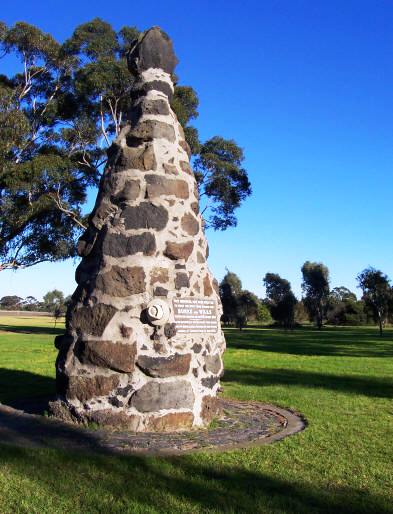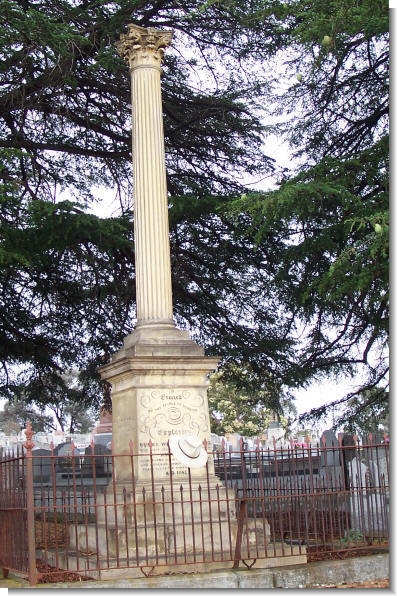The following short article was first published in the
weekly White Hat Melbourne Newsletter
No.413 - 20th August 2010
Melbourne Joins the Race for Broadband
"150 years ago this month Melbourne joined the race for broadband
domination of Australia. The colony of Victoria flush with money from
its resources boom equipped and funded the Burke & Whstsisname
expedition to find a path across the continent to the far north. This
expedition had a number of purposes. Finding new grazing land would be
very good. Scientific study would be laudable - even though much of the
scientific equipment had to be ditched once the going got tough. Beating
the other colonies to this achievement would be very good. But a
particular aim, often ignored by modern retellings, was to find a
possible route from the north for an overland telegraph to help
establish Melbourne as the communications and information hub of
Australia.
Information from England and Europe arrived via boat and this could
take up to three months. The boats sailed down the west coast of Africa,
around the Cape of good Hope and picked up the winds of the roaring
forties and charged off for Melbourne often crashing into bits of
Australia along the way if they placed more reliance on good hope than
good navigation. Melbourne, the gold capital, was where you were heading
as your first port of call, then after that you might head on to Sydney.
Melbourne got the news first and then repackaged it in our local
newspapers and shipped it off to the lesser colonies. Even
little Johnny Fawkner�s
hotel promoted itself as having a selection newspapers newly arrived
from England. Gentlemen�s
Clubs, upmarket hotels and major libraries still prided themselves
up until the 1960s on having airmail edition (printed on ricepaper to
reduce their weight) newspapers direct from Europe.
Communication from Melbourne to Sydney and Adelaide could be done by
ship, but depending on conditions, this was often faster over land. Like
most of our early public services, Melbourne�s first mail service to and
from Sydney was operated by a private operator who galloped the mail to
and from Howlong on the Murray where it met up with the NSW operator.
Similar overland mail was available to Adelaide.
However, an annoying trend had emerged that could threaten
Melbourne�s dominance as a communications hub. Some ships from England
were stopping off first in Perth. That didn�t matter because Western
Australia was (and some think, still is) a different country with no
overland contact with civilisation which was to be found on the east
coast. However ships were also stopping in Adelaide. To Melbourne�s
enduring chagrin, we only found out from a ship docked in Adelaide and
the news travelling over land that Victoria had been made a colony
separate form NSW. Adelaide had become the place where you heard it
first and spread it to the rest of Australia. Both Sydney and Melbourne
newspapers assigned reporters to that dreary upstart metropolis to try
to pounce on the information as it arrived form England and get it back
to their respective cities by whatever means possible as fast as they
could.
But a new technology was emerging. The telegraph! Electrical impulses
sent along wires had the potential to make their way to and from Europe
in a fraction of the time taken by a ship. Laying telegraph lines across
inhabited countryside was a relatively easy process and lines from
Europe were already approaching South East Asia. An undersea cable could
link them with Australia. Western Australia and Queensland both put up
proposals, but the best route seemed to be that taken by the early
Aboriginal people when they arrived from Asia. Unlike the fiction taught
in some schools that Aboriginal people arrived via a land bridge, we
know that there was a major over-the-horizon sea voyage to be negotiated
and despite changing sea levels this trench between Java and Australia
still remained the major obstacle but shortest route for an undersea
cable. However once on land near Darwin, whichever colony could link
overland to this cable could become the information hub of Australia.
Burke and Whatsisname were already on their camels, however
Whatsisname was quickly disillusioned with Burke and got replaced by
Wills. But Adelaide was not to be outdone. John McDouall Stuart had been
engaged to mount an expedition with a major goal of finding the route
for a telegraph line from the top end to Adelaide. We know now of course
that he succeeded and his exploration led to the establishment of the
overland telegraph to Adelaide, while Burke & Wills perished in the
wilderness. However there was no point in just having a telegraph to
Adelaide. Connection had to be made with the rest of Australia, and
South Australia commenced building a telegraph line in the direction of
Melbourne. The early sections were not promising because an existing
private telegraph was already operating there. It would not be ethical
to use taxpayer money to undercut its competitor so the government used
a strategy which became a blueprint for governments of all descriptions
since then � buy out the private operator, dismantle his infrastructure,
create a monopoly and quietly bump up the prices. Telegraph connection
between Adelaide and Melbourne as well as Melbourne and Sydney had been
established by 1858 and in the following decade reliable telegraph
connection was established across Bass Strait.
Even if the news arrived first in Adelaide it had to be transmitted
first to Melbourne before it got to Sydney, and Melbourne and Sydney
newspapers competed as strongly as today for a scoop. It would not be
ethical or Christian for the proprietor of a Melbourne newspaper to
bribe the local telegraph office to delay the transmission of a story
until after their print deadlines. It would however be a thoroughly
Christian thing to do to block the line from all other traffic by paying
to transmit whole chapters of the Bible for hours on end until the print
deadline had passed.
The overland telegraph was completed in 1872, but by that time
Adelaide had direct contact with Sydney, bypassing Melbourne � you can�t
trust these croweaters. Melbourne had lost its broadband race.
This weekend was to see a number of activities celebrating the 150th
anniversary of the Burke & Wills expedition. These events have been
postponed because of the election. However, when they re-emerge, it is
worth remembering that if their expedition had been successful,
Melbourne might now be the technological and information hub of South
East Asia."
You can find a large monument to Burke & Wills in the centre of Melbourne,
as well as a memorial cairn in a city park commemorating the point of
departure.
Memorials to Burke & Wills abound throughout Australia. As wall as their
impressive grave in Melbourne
General Cemetery, you will find:
- A monumental bronze statue in the centre of Melbourne. This monument
has been moved four times since its installation. The
Streeton painting of the statue
(currently hanging in the
NGVA, Melbourne)
shows it outside the
Princess Theatre.
- A memorial cairn in
Royal Park commemorating their point of departure
- A large memorial fountain in the main street of
Ballarat
- A large monument to Burke & Wills in
Bendigo Cemetery
- The Burke Museum in
Beechworth
- A monument to Burke in
Castlemaine
- The Dig Tree, the Burke Tree and various other monuments at Coopers
Creek
Monuments to Burke & Wills and of
John King (survivor) are
visited on the Walking Tour of
Melbourne General Cemetery.
 |
The memorial in Melbourne General Cemetery consists of a massive
granite slab. Around the four sides of the base are thee following
inscriptions:
IN MEMORY OF
ROBERT O'HARA
BURKE
AND
WILLIAM JOHN WILLS
|
LEADER
AND SECOND IN COMMAND
OF THE
VICTORIAN EXPLORING EXPEDITION
DIED
AT COOPER'S CREEK
JUN 1861.
|
COMRADES IN A GREAT ACHIEVEMENT
COMPANIONS IN DEATH
AND
ASSOCIATES IN
RENOWN
|
THE FIRST TO CROSS
THE
CONTINENT OF AUSTRALIA
BURKE
WILLS
GRAY
KING
SURVIVOR.
|
In addition, a separate stone stands out the front with the
following inscription:
|
VISITED
BY THE COUNCIL
OF THE
OLD COLONISTS ASSOCIATION
OF VICTORIA, 20TH AUGUST 1910
THE 50TH
ANNIVERSARY OF THE
STARTING OF BURKE & WILLS
FROM
MELBOURNE FOR
COOPER'S CREEK, QUEENSLAND,
20TH
AUGUST 1860
|
|
| Visit this grave on White Hat Tours'
highly entertaining and informative
Tour of
Melbourne Cemetery. The tombstone of the sole
survivor, John King, is
also in Melbourne Cemetery, as is that of
John Macadam - a
prominent member of the Exploration Committee.
|

Burke and Wills Monument in
Royal Park
|
This monument in Royal Park states:
THIS MEMORIAL HAS BEEN ERECTED
TO MARK
THE SPOT FROM WHENCE THE
BURKE AND WILLS
EXPEDITION
STARTED ON THE 20TH AUGUST 1860
AFTER SUCCESSFULLY ACCOMPLISHING THEIR
MISSION
THE TWO BRAVE LEADERS PERISHED ON THEIR RETURN
JOURNEY AT COOPERS CREEK IN 1861.
|
|
 |
|
- A famous painting by
William Strutt
hanging in the Cowen
Gallery shows Robert O'Hara Burke being buried at Coopers Creek.
However there is a large monument in
Melbourne General Cemetery
to Burke and Wills. Where are Burke and Wills really buried?
- The Burke and Wills Statue in recent years has occupied several
positions in or near the City Square. What was its original position
(hint � try page 1 of the great murder mystery yarn
Mystery of a Hansom Cab) and why
was it shifted? What was its second position (hint you will find it
there in a Tom Roberts painting) and
why was it shifted again after that?
- The monument in Melbourne General Cemetery names William John Wills
as the Second in Command of the expedition. Was that his position when
the expedition left Melbourne?
- Ballarat has a Burke and Wills Fountain and Bendigo has a large
monument to Burke and Wills in their cemetery. Did the Burke and Wills
expedition pass through these two settlements?
Some forthcoming events related to Robert O'Hara Burke: